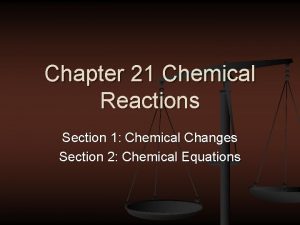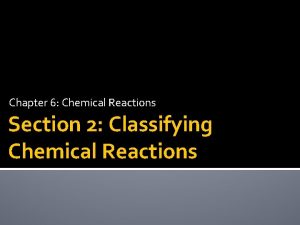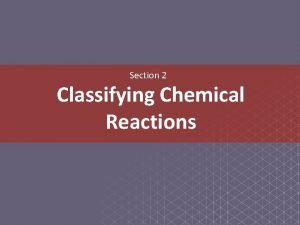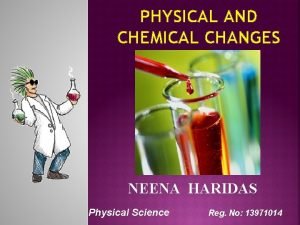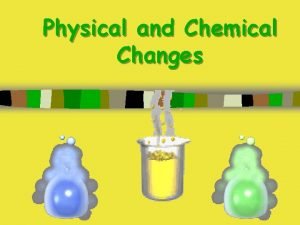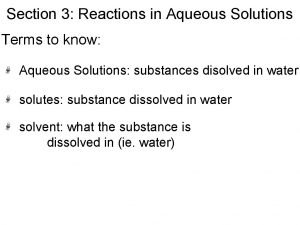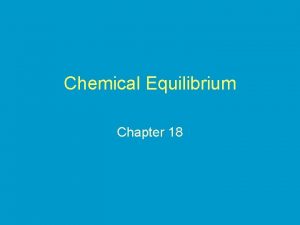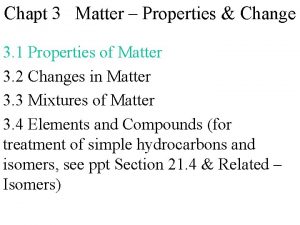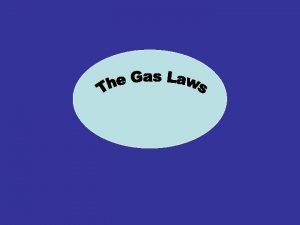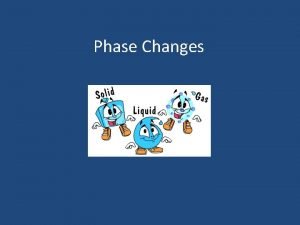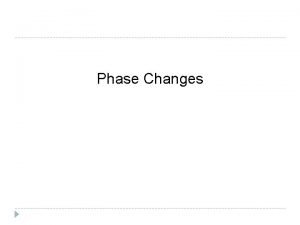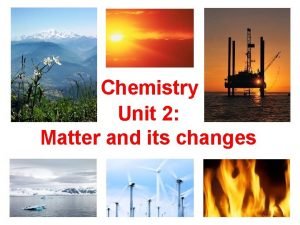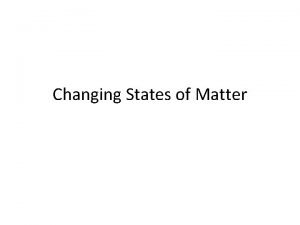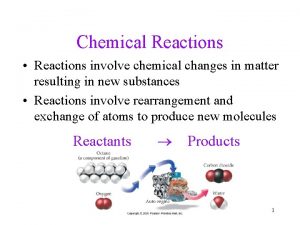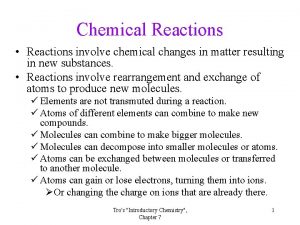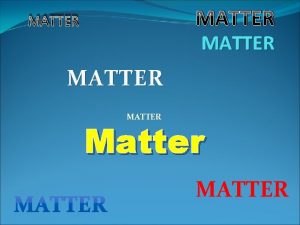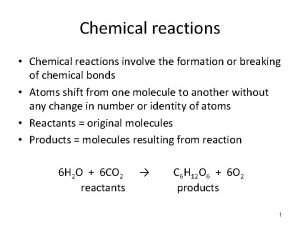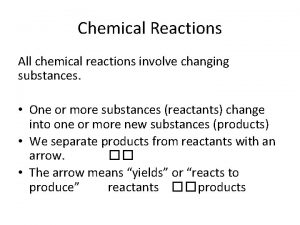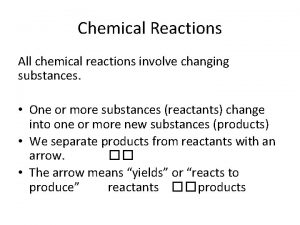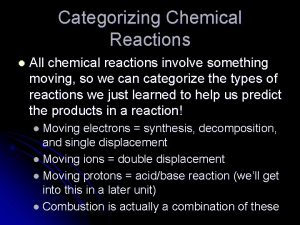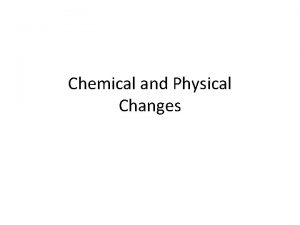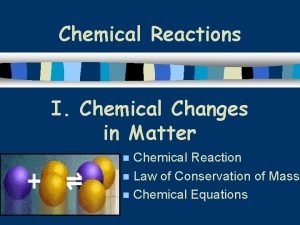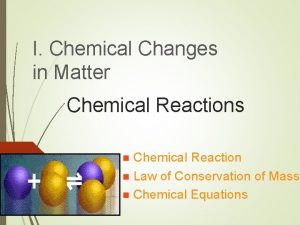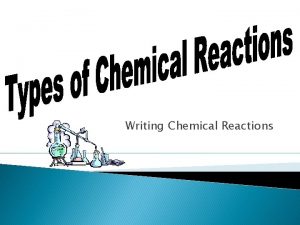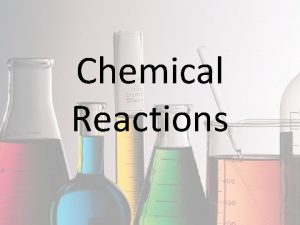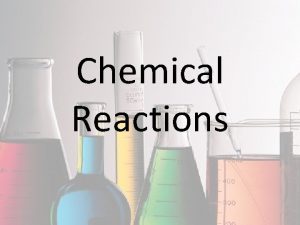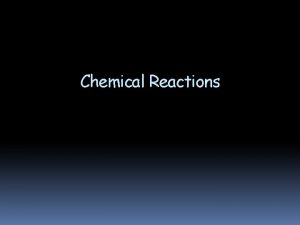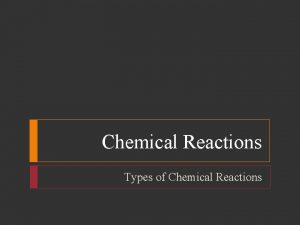Chemical Reactions Reactions involve chemical changes in matter

















- Slides: 17

Chemical Reactions • Reactions involve chemical changes in matter resulting in new substances being formed. • Reactions involve rearrangement and exchange of atoms to produce new substances. Reactants Products

Evidence of Chemical Reactions • • Look for evidence of a new substance Visual clues (permanent) that indicate a reaction has occurred: – color change – precipitate formation – • solid that forms when liquid solutions are mixed gas bubbles – large energy changes • emission of light • Production of flame • Other indications: – new odor – whooshing sound from a tube – permanent new state – temperature change

Describing chemical reactions by formulas • We want to put enough information into the formula so that we can understand exactly what happens. • Sodium reacts with water to give off hydrogen and produces sodium hydroxide solution. • Na(s) + H 2 O(l) H 2(g) + Na. OH(aq) • We show that solid sodium reacts with liquid water to give off gaseous H 2 and aqueous sodium hydroxide.


Chemical Equation • • Shorthand way to describe a reaction Provides information about the reaction – Formulas of the reactants and products – Gives the “states” of the reactants and products – Relative numbers of reactant and product molecules that are required – Can be used to determine amounts of reactants used and amounts of products produced in the reaction Matter cannot be created or destroyed – Therefore the total mass cannot change – and the total mass of the reactants will be the same as the total mass of the products In a chemical reaction, all the atoms present at the beginning must still be present at the end of the reaction – if all the atoms are still there, then the mass cannot change

Atoms are conserved in a chemical reaction!

Law of Conservation of Mass Na(s) + H 2 O(l) H 2(g) + Na. OH(aq) The number of each type of element in the reactants is the same as the number of each type of element in the products. To achieve this we need to balance the chemical equation. In balancing a chemical equation we can change the number of reactants or products, but never their chemical composition (identities or formulas)

Balancing a Chemical Equation Allowed: Balance the equation by adding coefficients to the left of the chemical formulas: Na(s) + H 2 O(l) H 2(g) + 2 Na. OH(aq) Not allowed: Change a chemical formula to make an element balance (balancing H) Na(s) + H 3 O(l) H 2(g) + Na. OH(aq) Not allowed: Add more chemical species for convenience (balancing all elements) Na(s) + H 2 O(l) + H H 2(g) + Na. OH(aq)

Balanced Chemical Equation 2 Na(s) + 2 H 2 O(l) H 2(g) + 2 Na. OH(aq) Element # Atoms in reactants # Atoms in products Na 2 2 H 4 4 O 2 2

Balancing Chemical Equations: “Formal Approach” To balance a chemical equation, do not change any molecules or atoms, but change the number of molecules KCl. O 4 KCl + O 2 1. Place a ‘ 1’ in front of the molecule with the greatest number of atoms. If two molecules have the same number of atoms, then choose the molecule with the greatest number of different elements (this number may change) 1 KCl. O 4 KCl + O 2

Balancing Equations 2. Insert coefficients that balance elements that are in compounds with more than one different element 1 KCl. O 4 1 KCl + O 2 3. Place coefficients in front of all else to balance remaining elements 1 KCl. O 4 1 KCl + 2 O 2

4. Clear fractions, if any, and multiply/divide by a common denominator. If, for instance, we get the following balanced equation. . . 4 KCl. O 4. . . then divide by 4 to get. . . 1 KCl. O 4 4 KCl + 8 O 2 1 KCl + 2 O 2 5. Check to be sure the final equation is balanced Reactants Products 1 K, 1 Cl, 4 O Balanced Chemical Equation: KCl. O 4 KCl + 2 O 2

Simple, Systematic Approach Balance the following equation: Mg. CO 3 + HCl Mg. Cl 2 + CO 2 + H 2 O 1. In how many compounds does each element appear? Choose the element with the lowest number. Element Mg C O H Cl Number of compounds in equation 2 2 3 2 2

2. After choosing the element that appears in the fewest number of compounds, balance the number of atoms of that element (i. e. , balance the number of Mg, C, H, Cl atoms) Mg 1 Mg. CO 3 + HCl 1 Mg. Cl 2 + CO 2 + H 2 O C 1 Mg. CO 3 + HCl 1 Mg. Cl 2 + 1 CO 2 + H 2 O H 1 Mg. CO 3 + 2 HCl 1 Mg. Cl 2 + 1 CO 2 + H 2 O Note that you can ‘coincidentally’ balance more than one element at a time (such as Cl)

Mg. CO 3 + 2 HCl Mg. Cl 2 + CO 2 + H 2 O 3. Always check to confirm that the equation is balanced Reactants Products 1 Mg, 1 C, 3 O, 2 H, 2 Cl 1 Mg, 2 Cl, 1 C, 3 O, 2 H Balanced Chemical Equation: Mg. CO 3 + 2 HCl Mg. Cl 2 + CO 2 + H 2 O

Balance by Inspection Cu + S Cu 2 S 1. Determine the required number of compounds by visually inspecting the chemical equation. This is often the fastest method for simple equations. 2 Cu + S Cu 2 S 2. Always check to confirm that the equation is balanced Reactants Products 2 Cu, 1 S

Now Your Turn Balance the following chemical equations: CO + O 2 CO 2 P 4 + Cl 2 PCl 3 P + O 2 P 2 O 3 C 3 H 8 + O 2 CO 2 + H 2 O Notice that on at least one reaction, you may be able to balance the reaction just by inspecting it
 Section 1 chemical changes
Section 1 chemical changes Chemical reactions section 2 classifying chemical reactions
Chemical reactions section 2 classifying chemical reactions Chemical reactions section 2 classifying chemical reactions
Chemical reactions section 2 classifying chemical reactions What is a phisical change
What is a phisical change True or false: chemical and physical changes alter matter.
True or false: chemical and physical changes alter matter. Types of reactions
Types of reactions Chapter 18 chemical reactions balancing chemical equations
Chapter 18 chemical reactions balancing chemical equations Elizabeth mulroney
Elizabeth mulroney Which is a “big idea” for matter and change?
Which is a “big idea” for matter and change? Matter-properties and changes answer key
Matter-properties and changes answer key Endothermic reaction characteristics
Endothermic reaction characteristics Change in state of matter
Change in state of matter Stp law
Stp law 5 phases of matter
5 phases of matter Two types of changes
Two types of changes Phase change descriptions
Phase change descriptions Definition of substance
Definition of substance Concept map matter
Concept map matter
